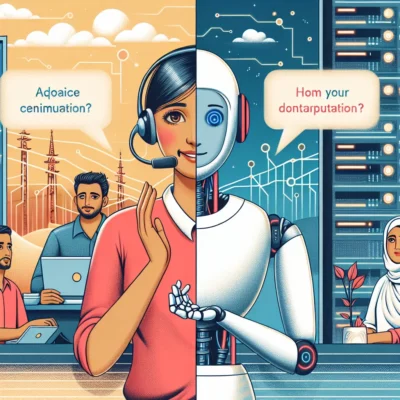Introduction: The Rise of AI in Customer Engagement
Artificial Intelligence (AI) has revolutionized customer service and brand enhancement, offering unprecedented efficiency and personalization. From chatbots handling customer inquiries to AI-driven analytics providing insights into consumer behavior, the adoption of AI in businesses is accelerating. According to recent statistics, over 70% of businesses are now integrating AI into their customer service strategies, aiming to improve customer satisfaction and operational efficiency.
However, the rapid deployment of AI technologies comes with its own set of challenges. Potential drawbacks such as the lack of human touch, data privacy concerns, technological limitations, and cost implications necessitate robust mitigation strategies. This whitepaper explores these pitfalls and offers practical solutions for businesses to navigate the complex landscape of AI in customer engagement.
The Potential Drawbacks of Relying Solely on AI
Lack of Human Touch
AI systems, while efficient, often lack the empathy and emotional intelligence that human agents bring to customer interactions. This absence of a personal touch can lead to customer dissatisfaction. For instance, a customer dealing with a sensitive issue may find an AI’s response impersonal and frustrating, impacting their trust and loyalty towards the brand. Real-life examples include automated responses that fail to address the specific concerns of customers, leading to negative experiences and potential loss of business.
Data Privacy Concerns
AI systems rely heavily on data collection to function effectively. This practice raises significant data privacy concerns, including the risks of data breaches and misuse of personal information. Businesses must navigate complex regulatory landscapes to ensure compliance with data protection laws. Failure to do so can result in severe legal and financial repercussions, as well as damage to the brand’s reputation.
Technological Limitations
Despite advancements, AI technology still struggles with complex or nuanced queries that require a deeper understanding of context. Instances of AI system failures or errors are not uncommon, often stemming from the reliance on high-quality data for accurate performance. These limitations can hinder the effectiveness of AI in customer service, necessitating human intervention to resolve intricate issues.
Cost and Maintenance
Implementing AI systems involves significant initial investments and ongoing maintenance costs. Businesses must budget for regular updates and training to keep AI systems efficient and relevant. Additionally, hidden costs related to the integration of AI with existing systems can strain financial resources, making it crucial for businesses to conduct thorough cost-benefit analyses before committing to AI solutions.
Mitigation Strategies for Businesses
Incorporating Human Oversight
A hybrid approach that combines AI and human agents can mitigate the drawbacks of relying solely on AI. Seamless handoffs between AI and human support ensure that complex or sensitive issues are handled with the necessary empathy and expertise. Training customer service teams to manage AI escalations effectively can enhance overall customer satisfaction.
Enhancing Data Security
Securing customer data is paramount. Businesses should implement best practices such as robust encryption, access control measures, and regular audits to safeguard personal information. Compliance checks with data protection regulations are essential to avoid legal pitfalls and maintain customer trust.
Continuous Improvement and Monitoring
Regular updates and system improvements are critical for maintaining AI performance. Monitoring AI interactions and gathering customer feedback can provide valuable insights for refining AI systems. Adapting to evolving customer needs and technological advancements ensures that AI remains a valuable asset in customer engagement.
Cost-Benefit Analysis
Before implementing AI, businesses should conduct thorough cost-benefit analyses to understand the financial implications. Budgeting for unexpected costs and ongoing maintenance is crucial. Exploring scalable AI solutions tailored to the business’s size and needs can provide a balanced approach to leveraging AI technology.
Real-World Examples and Case Studies
Several businesses have successfully integrated AI into their customer engagement strategies with minimal drawbacks. For instance, a leading e-commerce company uses AI-driven chatbots to handle routine inquiries, freeing up human agents for more complex issues. Conversely, there are case studies highlighting failures, such as AI systems that provided incorrect information, leading to customer frustration. Insights from industry leaders emphasize the importance of balancing AI with human elements to achieve optimal customer engagement.
Future Outlook: AI and Human Synergy
The future of AI in customer service looks promising, with emerging technologies poised to enhance AI capabilities further. Innovations such as natural language processing and advanced machine learning algorithms are expected to improve AI’s ability to understand and respond to customer needs. The role of humans in this AI-driven landscape will continue to evolve, focusing on tasks that require emotional intelligence and critical thinking.
Final Thoughts: Striking the Right Balance
In conclusion, while AI offers significant benefits in customer engagement, it is essential to strike the right balance between automation and human touch. Businesses must stay informed and adaptable, continuously refining their AI strategies to meet changing customer expectations. By addressing the potential pitfalls and implementing effective mitigation strategies, businesses can harness the power of AI to enhance customer satisfaction and loyalty.
